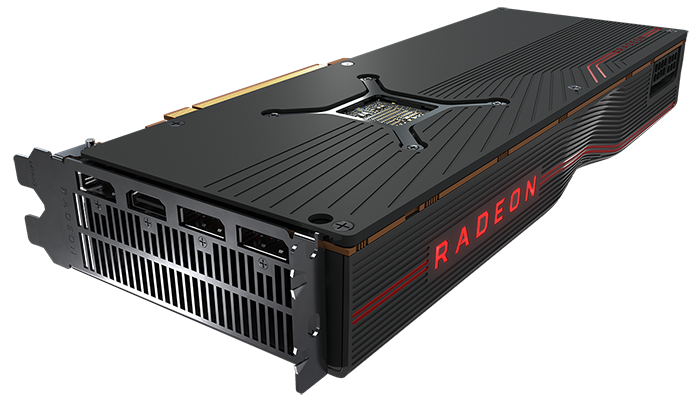
There's more to AMD's advanced 7nm technology platform than 3rd Gen Ryzen CPUs. On the graphics front, the chip giant has simultaneously launched the world's first Navi GPUs; Radeon RX 5700 XT and Radeon RX 5700.
Aimed at the mid-to-high-end segment and primed for high-quality gaming at a 1440p (QHD) resolution, the duo represents a changing of the guard as the new RDNA architecture steps in to take over from outgoing GCN. Let's take a look at how the cards stack up.
Radeon RX 5700 XT |
Radeon RX 5700 |
Radeon VII |
Radeon RX Vega 64 |
Radeon RX Vega 56 |
|
|---|---|---|---|---|---|
| Launch date | July 2019 |
July 2019 |
February 2019 |
August 2017 |
August 2017 |
| Codename | Navi 10 |
Navi 10 |
Vega 20 |
Vega 10 |
Vega 10 |
| Architecture | RDNA |
RDNA |
GCN |
GCN |
GCN |
| Process (nm) | 7 |
7 |
7 |
14 |
14 |
| Transistors (bn) | 10.3 |
10.3 |
13.2 |
12.5 |
12.5 |
| Approx Die Size (mm²) | 251 |
251 |
331 |
486 |
486 |
| Full Implementation of Die | Yes |
No |
No |
Yes |
No |
| Processors | 2,560 |
2,304 |
3,840 |
4,096 |
3,584 |
| Texture Units | 160 |
144 |
240 |
256 |
224 |
| ROP Units | 64 |
64 |
64 |
64 |
64 |
| Boost Clock (MHz) | 1,905 |
1,725 |
1,800 |
1,546 |
1,471 |
| Game Clock (MHz) | 1,755 |
1,625 |
- |
- |
- |
| Peak GFLOPS (SP) | 9,750 |
7,950 |
13,824 |
12,665 |
10,544 |
| Memory Type | GDDR6 |
GDDR6 |
HBM2 |
HBM2 |
HBM2 |
| Memory Size (GB) | 8 |
8 |
16 |
8 |
8 |
| Memory Clock (MHz) | 14,000 |
14,000 |
1,000 |
945 |
800 |
| Memory Bus (bits) | 256 |
256 |
4,096 |
2,048 |
2,048 |
| Max Bandwidth (GB/s) | 448 |
448 |
1,024 |
484 |
410 |
| PCIe Support | Gen 4 |
Gen 4 |
Gen 3 |
Gen 3 |
Gen 3 |
| Power Connectors | 6+8 |
6+8 |
8+8 |
8+8 |
8+8 |
| TDP (watts) | 225 |
180 |
300 |
295 |
210 |
| GFLOPS per watt | 43.3 |
44.2 |
46.1 |
42.9 |
50.2 |
| Launch MSRP | $399 |
$349 |
$699 |
$499 |
$399 |
The first interesting tidbit is that launch MSRPs are lower than the RX Vega cards being replaced. RX 5700 XT costs a full $100 less than RX Vega 64, while RX 5700 is priced $50 below the outgoing RX Vega 56. It is, in this day and age, unusual to see a newer release priced lower than the GPU being replaced, and don't assume the keen price tag to be an admission of reduced performance.
On the contrary, AMD anticipates a 50 per cent performance increase between GCN and RDNA when using the same number of compute units (CUs). A classic case of a newer architecture doing more with less, and the increased efficiency is reflected in the lean specifications of both Navi GPUs.
The flagship card at launch, the RX 5700 XT, priced at $399, carries 2,560 stream processors arranged in 40 compute units. That's almost a staggering 40 per cent less than the previous-generation RX Vega 64, and RX 5700 lowers the processor count to 2,304 by disabling a further four CUs. These aren't the brute-strength Radeons of yesteryear, and as part of the streamlining process, AMD has opted against expensive-to-produce HBM2 memory, settling instead for readily available GDDR6.
Taking a different approach to the competition, there's also no dedicated hardware for ray-tracing. Keeping things simple is the name of the game, and AMD is prepared to wait it out and see what the future brings for ray-traced gaming. In an interesting twist, the new Radeons instead look to the future by being the first consumer graphics cards to support the forward-looking PCIe Gen 4 interface, doubling GPU-to-system bandwidth from 16GB/s to 32GB/s.
Both Navi cards are designed with high-resolution gaming in mind, hence the same complement of 64 ROPs, a 256-bit memory bus and an 8GB frame buffer operating at 14Gbps. The numbers themselves appear fairly ordinary, yet the under-the-hood enhancements to the RDNA architecture allow the Radeon RX 5000 Series to comfortably outperform most previous Radeon graphics cards.
This time around, each Navi CU is outfitted with an additional scalar unit and a second scheduler to offer double the instruction rate, and the RDNA design also benefits from dual SIMD32 instructions with a single-clock issue, rather than a four-clock SIMD16, making the GPU better suited to common gaming workloads.
The list of improvements doesn't end there. Navi benefits from dedicated L1 cache, more on-chip bandwidth, reduced latency and enhanced compression algorithms that, in keeping with the general theme, help make the entire design more efficient.
Such upgrades are welcome, and the major strength of TSMC's 7nm fabrication process is that the 10.3-billion transistor Navi die measures just 251mm². Small, efficient and powerful are key attributes for any successful GPU, and Navi harnesses the advantages of 7nm by raising peak frequencies to 1,905MHz for the RX 5700 XT and 1,725MHz for RX 5700.
Put it all together and you have not only the most elegant Radeon GPUs to date, but also two of the most efficient, keenly-priced graphics cards ever designed for high-quality QHD gaming.









